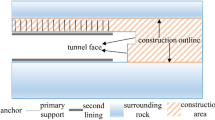Abstract
A concrete cofferdam of a hydropower project in India had to be demolished within a limited time period due to impoundment of river water. The cofferdam was trapezoidal at bottom and middle, rectangular at the top and abutted to one of the spillway piers. Two more spillway piers, spillway gates and a dam were very close to it. The length and height of cofferdam were 62 m and 24 m, respectively. For demolition of cofferdam, a new controlled blasting technique was developed after conducting test blasts at different locations. Two test blasts with varying blast designs and charging patterns were conducted at the farthest end of cofferdam which was free from other structures. Two more test blasts were conducted near the abutted portion with a very light explosive charge per hole fired in delayed sequence using half-second electric detonators. Results of the test blasts, particularly ground vibrations, throw of blasted materials and breakage patterns were analysed critically. Based on the results, a cautious blasting zone was determined near the abutted portion and controlled blasting patterns were designed. The formation of a zone of disturbance from cautious blasts at the abutted end for every concrete lift significantly reduced the magnitudes of vibration waves for successive blasting operations in remaining portion of that lift. The use of half-second delay detonators helped in segregating the vibration waves from the holes fired in different delays. The demolition work completed safely within the time limit using cautious blasting technique and systematic sequencing of blasts.


















Similar content being viewed by others
Availability of data and material
The datasets generated during the current study are not publicly available but can be available from the corresponding author on reasonable request.
Code availability
Not applicable.
References
Ak H, Iphar M, Yavuz M, Konuk A (2009) Evaluation of ground vibration effect of blasting operations in a magnesite mine. Soil Dyn Earthq Eng 29(4):669–676
BS 7385-2 (1993) Evaluation and measurement for vibration in buildings-Part-2: guide to damage levels from groundborne vibration. British Standard Institution, London
Chae YS (1978) Design of excavation blasts to prevent damage. Civ Eng ASCE 48(4):77–79
CSIR-CIMFR Interim Report (2016) Design of controlled blasting pattern for safe demolition of concrete coffer wall at Teesta Low Dam Project, Stage-IV of NHPC Limited, Darjeeling District, West Bengal. CNP/4292/2015-16, India
Directorate General of Mines Safety (DGMS) (1997) Technical Circular No. 7, India
Dowding CH (1985) Blast vibration monitoring and control. Prentice-Hall Inc., Eaglewood Cliffs
Duvall WI and Fogelson DE (1962) Review of criteria for estimating damage to residences from blasting vibrations. United States Bureau of Mines RI 5968
Edwards AT, Northwood TD (1960) Experimental studies of the effects of blasting on structures. Engineer 210:538–546
Elevli B, Arpaz E (2010) Evaluation of parameters affected on the blast induced ground vibration by using relation diagram method. Acta Montan Slovaca 15(4):261–268
Esteves JM (1978) Control of vibrations caused by blastin. Memoria 409. Laboratorio de Engenharia Civil, Ministerio de Habitacao e Obras Publicas, Lisbon
Khandelwal M, Singh TN (2006) Prediction of blast induced ground vibrations and frequency in opencast mine: a neural network approach. J Sound Vib 289(4–5):711–725
Langefors U, Kihlstrom B (1978) The modern technique of rock blasting. Wiley, Hoboken, p 405
Nateghi R (2011) Prediction of ground vibration level induced by blasting at different rock units. Int J Rock Mech Min Sci 48(4):899–908
Oriard LL (2002) Explosives engineering, construction vibrations and geotechnology. International Society of Explosives Engineers (ISEE), Cleveland
Ozer U (2008) Environmental impacts of ground vibration induced by blasting at different rock units on the Kadikoy-Kartal metro tunnel. Eng Geol 100(1–2):82–90
Singh RK, Sawmliana C, Hembram P (2020) Damage threat to sensitive structures of a thermal power plant from hard rock blasting operations in track hopper area: a case study. Int J Prot Struct 11(1):3–22
Siskind DE, Stagg MS, Koop JW and Dowding CH (1980) Structure response and damage produced by ground vibration from surface mine blasting. United States Bureau of Mines RI 8507, p 74
Tripathy GR, Shirke RR, Kulade MD (2016) Safety of engineered structures against blast vibrations: a case study. J Rock Mech Geotech Eng 8:248–255
Funding
The authors received no financial support for the research, authorship and/or publication of this article.
Author information
Authors and Affiliations
Corresponding author
Ethics declarations
Conflict of interest
The authors declare no potential conflicts of interest with respect to the research, authorship and/or publication of this article.
Rights and permissions
About this article
Cite this article
Singh, R.K., Sawmliana, C. & Hembram, P. Time-constrained demolition of a concrete cofferdam using controlled blasting. Innov. Infrastruct. Solut. 6, 20 (2021). https://doi.org/10.1007/s41062-020-00387-8
Received:
Accepted:
Published:
DOI: https://doi.org/10.1007/s41062-020-00387-8




